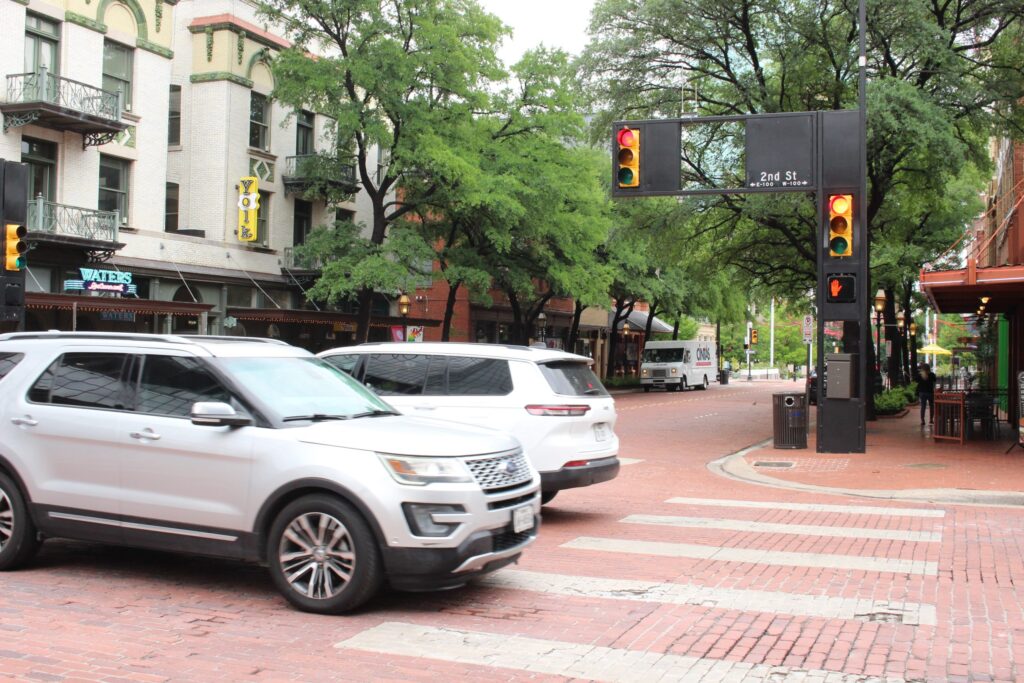Fort Worth is moving forward with its program to update pedestrian ramps and traffic signals downtown, with the project to proceed in two phases and paused to allow for play of the FIFA World Cup 26 games in DFW. — Brian Farda
Documenter name: Brian Farda
Agency: Fort Worth Public Meetings
Date: April 24, 2025
See more about this meeting at Documenters.org

Documenters empowers people like you to help fill the gaps in reporting on Tarrant County public meetings. Find out how you can join here.
Notes
Fort Worth is planning upgrades to seven intersections (1st to 9th streets, but not 3rd or 4th) and enhancements for pedestrian safety along Main Street. City officials held a public Main Street Downtown Intersection Project meeting April 24, 2025, in the City Center board room downtown. The meeting began at 11 a.m. It was held in an open-house format with a short presentation at the beginning.
Present at the meeting were representatives from:
City of Fort Worth Transportation & Public Works
Lauren Prieur (TPW director)
Lara Ingram (TPW Communications, public information officer)
City of Fort Worth District 9
Mia Boatner (district director)
Bartlett & West engineering firm
Todd Milburn, design engineer
Brandon Johnson, lead designer
Project manager
Seth Cooksey opened the meeting with greetings, introductions and contact information. He then gave a presentation that included:
Project scopeTo upgrade the signalized intersections by installing powder-coated black poles, arms, pedestrian traffic signals, pan-tilt-zoom cameras, signage and ADA ramps on Main Street from 1st to 9th streets, except at 3rd and 4th streets; to construct power pedestals on 8th, 9th and Weatherford streets; to add signal battery backups to power pedestals at 3rd, 4th, 8th, 9th and Weatherford streets.
Project phasesPhase I will consist of updating traffic signals and improving sidewalk curb ramps at 1st and 2nd streets. Then, a new power pedestal and battery backup will be added at Weatherford and Main streets. Finally, a new battery backup will be added to existing power pedestals at 3rd and 4th streets.
Phase II will consist of updating traffic signals and improving sidewalk curb ramps at 9th, 8th, 7th, 6th and 5th streets. Then, a new power pedestal and battery backup will be added at 8th and 9th streets.
Why this project?The Main Street Downtown Intersection Project was funded by a 2022 Bond Program and is intended to upgrade pedestrian and vehicle traffic infrastructure to address the high number of pedestrian injuries along this major downtown thoroughfare.
The project addresses the aging signal infrastructure and custom-made parts no longer available. Moreover, Main Street has limited capability to run energy efficient signals during power outages.
The project proposes upgrades to meet current industry standards and overall safety improvements for all users. This also will include updates to the aesthetics of the signal system to match 3rd and 4th streets as well as improved pedestrian access elements such as ADA compliant curb ramps.
Project statusThe project is in its final submittal phase, which is due May 2025. This includes final plans, specifications and a final estimate.
Final designsConcept boards included the final design signals and sidewalk ramp visual renderings for each intersection. Additional photos showed the 3rd and 4th streets completed upgrades that will be extrapolated to the other intersections.
Improved access and traffic controlsContractors will be required to stage construction and sidewalk closures to maintain pedestrian access to all businesses and entrances. Contractors may also set up temporary street crossings to maintain pedestrian side street access.
Cooksey frequently noted that the Main Street Downtown Intersection Project is simply a continuation of infrastructure improvements that are already underway and in place at the 3rd Street and 4th Street intersections.
Todd Milburn took over the presentation shortly to cover the issue of pedestrian access to businesses along Main Street while these improvements are underway. He pledged to coordinate with and liaise between property owners and contractors in order to minimize any disruptions to nearby business operations. A key component of this will be prioritizing pedestrian access to businesses while construction is ongoing.
Cooksey continued his presentation and discussed the following:
Project schedule Currently completing the design phase
Contract execution for Phase I construction — spring 2025
Contract execution for Phase II construction — spring 2026
Estimated construction start for Phase I — summer 2025
Estimated construction start for Phase II — summer 2026
Estimated construction duration for Phase I — Five months
Estimated construction duration for Phase II — Eight months
Estimated total construction cost — around $2.6 million
FIFA World Cup 26 pauseThe World Cup event has been worked into the construction schedule to allow for the increased visitor traffic that is anticipated and the subsequent need for easy pedestrian access to businesses.
Cooksey then made some closing remarks, thanked attendees and opened the floor for questions. The Q&A session was brief and centered around possible disruptions to nearby businesses:
How long does it take to complete each corner? (Up to three weeks per corner.)
How long does it take to complete each intersection? (One to two months per intersection.)
Lastly, Cooksey noted that his project slide deck will be posted soon to the Fort Worth Main Street Downtown Intersections website.
There were approximately 25 attendees and presenters.
If you believe anything in these notes is inaccurate, please email us at [email protected] with “Correction Request” in the subject line.
Related
Fort Worth Report is certified by the Journalism Trust Initiative for adhering to standards for ethical journalism.
Republish This Story
![]()


